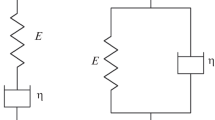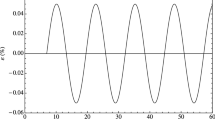Abstract
Fractional hereditary materials are characterized for the presence, in the stress-strain relations, of fractional-order operators with order β∈[0,1]. In Di Paola and Zingales (J. Rheol. 56(5):983–1004, 2012) exact mechanical models of such materials have been extensively discussed obtaining two intervals for β: (i) Elasto-Viscous (EV) materials for 0≤β≤1/2; (ii) Visco-Elastic (VE) materials for 1/2≤β≤1. These two ranges correspond to different continuous mechanical models.
In this paper a discretization scheme based upon the continuous models proposed in Di Paola and Zingales (J. Rheol. 56(5):983–1004, 2012) useful to obtain a mechanical description of fractional derivative is presented. It is shown that the discretized models are ruled by a set of coupled first order differential equations involving symmetric and positive definite matrices. Modal analysis shows that fractional order operators have a mechanical counterpart that is ruled by a set of Kelvin-Voigt units and each of them provides a proper contribution to the overall response. The robustness of the proposed discretization scheme is assessed in the paper for different classes of external loads and for different values of β∈[0, 1].











Similar content being viewed by others
References
Di Paola M, Zingales M (2012) Exact mechanical models of fractional hereditary materials. J Rheol 56(5):983–1004
Nutting PG (1921) A new general law of deformation. J Franklin Inst 191:679–685
Gemant A (1936) A method of analyzing experimental results obtained from elasto-viscous bodies. Physics 7:311–317
Di Paola M, Pirrotta A, Valenza A (2011) Visco-elastic behavior through fractional calculus: an easier method for best fitting experimental results. J Mater Sci 43(12):799–806
Gerasimov AN (1949) A generalization of linear laws of deformation and its application to inner friction problems. Prikl Mat Meh 12:251–259 (in Russian)
Scott Blair GW, Caffyn JE (1949) An application of the theory of quasi-properties to the treatment of anomalous strain-stress relations. Philos Mag 40(300):80–94
Slonimsky GL (1961) On the law of deformation of highly elastic polymeric bodies. Dokl Akad Nauk SSSR 140(2):343–346 (in Russian)
Bagley RL, Torvik PJ (1984) On the appearance of the fractional derivative in the behavior of real materials. J Appl Mech 51:294–298
Schiessel H, Blumen A (1993) Hierarchical analogues to fractional relaxation equations. J Phys A, Math Gen 26:5057–5069
Schiessel H, Metzeler R, Blumen A, Nonnenmacher TF (1995) Generalized viscoelastic models: their fractional equations with solutions. J Phys A, Math Gen 28:6567–6584
Heymans N, Bauwens JC (1994) Fractal rheological models and fractional differential equations for viscoelastic behavior. Rheol Acta 33:210–219
Bagley RL, Torvik PJ (1983) Fractional calculus—a different approach to the analysis of viscoelastically damped structures. AIAA J 21(5):741–748
Bagley RL, Torvik PJ (1986) On the fractional calculus model of viscoelastic behavior. J Rheol 30(1):133–155
Bagley RL (1989) Power law and fractional calculus model of viscoelasticity. AIAA J 27(10):1412–1417
Schmidt A, Gaul L (2002) Finite element formulation of viscoelastic constitutive equations using fractional time derivatives. Nonlinear Dyn 29(1):37–55
Spanos PD, Evangelatos GI (2010) Response of a non-linear system with restoring forces governed by fractional derivatives—time domain simulation and statistical linearization solution. Soil Dyn Earthq Eng 30(9):811–821
Yuan L, Agrawal OP (2002) A numerical scheme for dynamic system containing fractional derivatives. J Vib Acoust 124(2):321–324
Schmidt A, Gaul L (2006) On a critique of a numerical scheme for the calculation of fractionally damped dynamical systems. Mech Res Commun 33(1):99–107
Schmidt A, Gaul L (2006) On the numerical evaluation of fractional derivatives in multi-degree-of-freedom systems. Signal Process 86(10):2592–2601
Flügge W (1967) Viscoelasticity. Blaisdell, Waltham
Mainardi F (2010) Fractional calculus and waves in linear viscoelasticity. Imperial College Press/World Scientific, London
Yueh W-C (2005) Eigenvalues of several tridiagonal matrices. Appl Math E-Notes 5:66–74
Kouchi S (2006) Eigenvalues and eigenvectors of tridiagonal matrices. Electron J Linear Algebra 15:115–133
Podlubny I (1999) Fractional differential equations. Academic Press, San Diego
Oldham KB, Spainer J (1974) The fractional calculus: theory and applications of differentiation and integration to arbitrary order. Academic Press, New York
Caputo M (1967) Linear models of dissipation whose Q is almost frequency independent—II. Geophys J R Astron Soc 13:529–539. Reprinted recently in: Fract Calc Appl Anal 11(1):3–14, 2008
Miller KS, Ross B (1993) An introduction to the fractional calculus and fractional differential equations. Wiley-InterScience, New York
Samko GS, Kilbas AA, Marichev OI (1993) Fractional integrals and derivatives: theory and applications. Gordon & Breach, New York
Kilbas AA, Srivastava HM, Trujillo JJ (2006) Theory and applications of fractional differential equations. Elsevier, Amsterdam
Hilfer R (2000) Application of fractional calculus in physics. World Scientific, Singapore
Acknowledgements
The authors are very grateful to research Grant No. PRIN2008, National Coordinator Professor A. Carpinteri. This financial support is gratefully acknowledged.
Author information
Authors and Affiliations
Corresponding author
Appendix: Fractional calculus
Appendix: Fractional calculus
In this appendix we introduce some fundamental concepts on fractional calculus.
The fractional calculus is the natural extension of ordinary differential calculus. In fact, it extends the concepts of derivation and integration to non-integer and complex order.
The fractional calculus was born in the 1695 when G.W. Leibniz introduced the half derivate concept in a note to G. de l’Hôpital [24]. Subsequent studies have focused by different mathematicians [25]: J.B.J. Fourier, P.S. Laplace, L. Euler, S.F. Lacorix, N.H. Abel, etc.
The first definition of fractional operator is probably attributable to J. Liouville, who in 1832 gave the impulse to research by formulating the definition of fractional derivative of exponential function. In 1847, an important contribution was given by G.F.B. Riemann, who introduced their own definition of fractional integral. Following, N.Ya. Sonin unified formulations of Liouville and Riemann from multiple Cauchy integration formula [25], obtaining the following expression of fractional integral:

Equation (A.1) is known in literature as a fractional integral of Riemann-Liouville, since ℜ(β)>0, and it is valid for β∈ℂ.
To obtain the Riemann-Liouville fractional derivative just think that the derivative of order n can be considered as the derivative of order n+m of the mth primitive function, and then generalizing, we have:
valid for (n−1)<ℜ(β)<n.
Another definition of fractional integro-differential operator was provided in 1967 by M. Caputo [26]. This definition is easier to handle for the solution of physical problems. The Caputo fractional derivative has the following expression:
Equation (A.3) is valid for (n−1)<β<n. The expression obtained is the result of an interpolation between the integer order derivatives, in fact, for β→n, the expression becomes an nth derivative of f(t).
It can be observed that the expressions (A.3) and (A.2) coincide if we start from initial conditions zero (f(a)=0).
Another definition of fractional operator, which is suitable for the techniques of discretization, it’s known as Grünwald-Letnikov differintegral [25] and is given as

Equation (A.4) defines in the same time two different operators, fractional derivate (for β>0) and fractional integral (for β<0).
Many definitions of fractional operators exist but are not reported for brevity sake’s. For in-depth studies look at previous citied books and [27–30].
Rights and permissions
About this article
Cite this article
Di Paola, M., Pinnola, F.P. & Zingales, M. A discrete mechanical model of fractional hereditary materials. Meccanica 48, 1573–1586 (2013). https://doi.org/10.1007/s11012-012-9685-4
Received:
Accepted:
Published:
Issue Date:
DOI: https://doi.org/10.1007/s11012-012-9685-4




